By this time, you all are preparing for the
holidays and the end of 2005. It has been quite a year for our
Society’s standards activities that culminated in our many
standards meetings and session workshop in Santa Clara as well
as our annual Standards Advisory and Coordination Committee (SACCom)
luncheon with the Society’s Representative Advisory Committee
(RAC). In addition, internationally, the annual International
Electrotechnical Commission (IEC) Special International Committee
on Radio Interference (CISPR) held its meeting three weeks after
our Santa Clara Symposium in Shanghai, China. So, within 30 days,
we had major standards activity that is now summarized in this
article.
SDCom Activity: The EMCS Standards Development Committee
(SDCom) met for a half-day the first day and for two hours on
the third day of the Symposium week and focused on the following:
a. A continuing initiative that included SDCom working with
a GTEM user group to address issues of applicability, especially
above 1 GHz. Stephen Berger will chair the SDCom study project
on the subject.
b. A new initiative on wireless performance prediction that
is a proposed study project including members of the IEEE 802
committee.
c. A SDCom committee working on the EMC aspects of the FCC implementation
of so-called interference temperature and adaptive radio that
uses RF spectrum which is not used in time and which the interference
ambient is sufficiently low to allow the use of frequencies
in that ambient with sufficient signal to noise ratio. There
was progress to report on generating an MOU with the Communications
Society to work this initiative. This would have to be coordinated
with the IEEE 802 committee that has been approached to see
how the work can be divided between EMC aspects and data transmission
aspects that are in the respective areas of the two committees.
d. A presentation was made on lightning protection and apparent
to the presenter were technical flaws in the popular view of
the phenomena. This resulted in an action item to follow up
with a “white paper” indicating specific issues and
scope that would fall under the SDCom umbrella for a standard
on the subject. Depending on the arguments in the white paper,
the SDCom will have to decide how to proceed.
e. As usual, the status of the SDCom standards were addressed
(see Table 1 for the standards under the control of the EMCS).
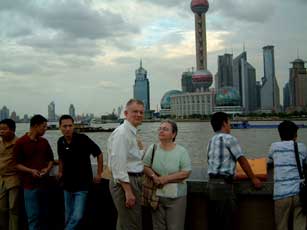 |
| Don and Lois Heirman take a weekend
break from the CISPR meetings to catch the sights in downtown
Shanghai. Note the massive landmark TV/radio tower in the
background. |
Table 1: Titles of EMCS Standards
i IEEE 139 - IEEE Recommended Practice for the Measurement
of Radio Frequency Emission from Industrial, Scientific, and
Medical (ISM) Equipment Installed on the Users Premises
ii IEEE 140 - IEEE Recommended Practice for the Minimization
of Interference from Radio Frequency Heating Equipment
iii IEEE 187 - IEEE Standard on Radio Receivers: Open Field
Method of Measurement of Spurious Radiation from FM and Television
Broadcast Receivers
iv IEEE 299 - IEEE Standard Method of Measuring the Effectiveness
of Electromagnetic Shielding Enclosures
v IEEE 376 - IEEE Standard for the Measurement of Impulse Strength
and Impulse Bandwidth
vi IEEE 377 - IEEE Recommended Practice for Communication Transmitters
vii IEEE 473 - IEEE Practice for an Electromagnetic Site Survey
(10 kHz to 10 GHz)
viii IEEE 475 - IEEE Measurement Procedure for Field Disturbance
Sensor (RF Intrusion Alarm)
ix IEEE 1128 - IEEE Recommended Practice for RF Absorber Evaluation
in the Range of 30 MHz to 5 GHz
x IEEE 1140 - IEEE Standard Procedures for the Measurement of
Electric and Magnetic Fields from Video Display Terminals (VDTs)
from 5 Hz to 400 kHz
xi IEEE 1302 - Guide for the Electromagnetic Characterization
of Conductive Gaskets in the Frequency Range of DC to 18 GHz
xii IEEE 1309 - IEEE Standard Method for the Calibration of
Electromagnetic Field Sensors and Field Probes, Excluding Antennas,
from 9 kHz to 40 GHz
xiii IEEE P1530 - Recommended Practice for the Design and Construction
of Calibration Artifacts for Cable and Connector Shielding Test
Fixtures for Frequencies from 1 Hz to 10 GHz
xiv IEEE P1597.1 - IEEE Standard for Validation of Computational
Electromagnetics (CEM) Computer Modeling and Simulation IEEE
P1597.2 - IEEE Recommended Practice for Computational Electromagnetics
(CEM) Computer Modeling and Simulation Applications
xv IEEE P1642 - Recommended Practice for Protecting Public Accessible
Computer Systems from Intentional EMI
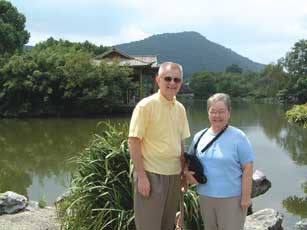 |
| The weekend after the CISPR meetings
provided an opportunity for Don and Lois Heirman to visit
the West Lake area of Hangzhou. |
The following reports were made on the projects
shown in Table 1:
1. 187: There is need for a working group (WG)
chairman to lead a revision of this standard. It was suggested
that this be discussed with representatives of CISPR Subcommittee
B, which generally covers the topic.
2. 140: Withdrawn
3. 187: Revised edition published
4. 299: Revision to clarify the use of the document underway.
Balloting by the end of 2004.
5. 376: Withdrawn
6. 377: Current
7. 473: Work progressing on update with 22 active participants
8. 475: Current
9. 1128: Reaffirmation ballot in process
10. 1140: Ready for reaffirmation ballot
11. 1302: In process, revision to be completed by end of 2004
12. 1309: Balloting comments being resolved with possible recirculation
ballot needed.
13. 1530: Inactive
14. 1597.1 and .2 Going to ballot in October
15. 1642: Draft standards due by end of year
SETCom Activity: Following the first
half of the SDCom meeting, the EMCS Standards Education Committee
(SETCom) met. The SETCom plans on sponsoring another EMC standards
workshop at the 2005 EMC Symposium in Chicago. Topics are expected
to include MIL-STD-461F, DO-160E, revisions of IEEE Standards
473, 376 and 139 (all projects sponsored by the EMC Society),
methods for determining measurement uncertainty and its application
in EMC measurement standards, and an overview of the European
Union harmonized EMC standards as well as the new EMC Directive.
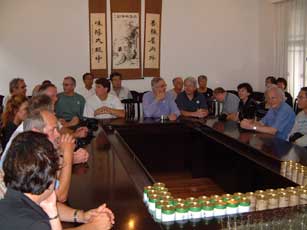 |
| CISPR delegates visiting a green
tea tasting clinic outside of Shanghai. |
SETCom Special Session: SETCom also held their annual special
session on standardization. This was held on Friday, August 13.
The purpose was to acquaint the international EMC community with
selected EMC standards and standards-related issues. This workshop,
which was chaired by John Kraemer of Rockwell Collins, included
presentations by several leaders in EMC standards development.
Don Heirman of Don HEIRMAN Consultants was the workshop’s
first presenter who spoke on the IEEE Standards Association and
the associated EMC Society standards development process. He answered
many questions from the audience, including several on how IEEE
standards relate to those from other standards organizations such
as ANSI, CISPR and IEC. Don is president-elect of the IEEE Standards
Association.
Dan Hoolihan of Hoolihan EMC Consulting presented an overview
of IEEE Std 1528, “IEEE Recommended Practice for Determining
the Peak Spatial-Average Specific Absorption Rate (SAR) in the
Human Head from Wireless Communication Devices: Measurement Techniques.”
His presentation included the measurement process and how the
results are presented.
In the area of digital television, FM and television broadcast
receivers, Mark Arthurs of Sony spoke on the work that he and
David Traver (Secretary of SDCom) completed in the leadership
of the much-needed revision of IEEE Std 187. On the international
front, Mark provided an overview of the draft CISPR multimedia
EMC standard being developed. The activity is centered on the
concept that a multimedia device is a host that has many cables
connected to its various input/output ports. These ports can have
connection to cabling from an antenna, audio/video equipment,
digital devices such as local area networks, etc. This device
can also be a computer or a TV/stereo receiver. Hence, can there
be one test for emissions that covers such broad categories of
devices? The WG believes that this is possible and that this new
multimedia test standard can then be applied to the broad range
of devices without performing several tests, as has been the case
in the past. For example, there are tests to different standards
depending on the individual type of device, i.e. TV receiver,
computer, etc.
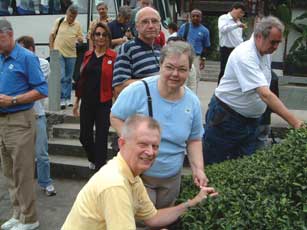 |
| Don and Lois Heirman join the CISPR
delegation visiting a green tea farm in Hangzhou. |
As the FCC and FDA have enjoyed a long and effective relationship
with both the ANSI ASC C63 and the IEEE EMC Society, Steven Berger
of TEM Consulting presented an overview of the ANSI ASC C63 committee
organization and current activities. The C63 group has several
on-going projects in areas such as measurement uncertainty, antenna
calibration, testing in RF absorber lined rooms, reverberation
testing, GTEM applications, medical device immunity, and lab accreditation.
Steve’s presentation provided points of contacts for each
of the many projects within C63 and its subcommittees. Steve is
also the chair of the IEEE EMC SDCom and is the EMCS representative
on ASC C63.
Andy Drozd of Andro Computational Solutions spoke on IEEE P1597,
“Computational Electromagnetics (CEM) Computer Modeling and
Simulation”, which is one of the several new and exciting
areas that the IEEE EMC SDCom is considering. The P1597 development
effort that Andy chairs actually has two parts: 1597.1, which
addresses validation of CEM application models, and 1597.2, which
is a recommended practice for CEM methodologies and solution techniques.
As with the other presenters, Andy was able to entertain questions
about the status of the project, specifically, where the technical
content was heading and how potential contributors can become
involved.
 |
| All enjoyed the CISPR farewell
banquet at the Park Hotel in Shanghai. |
SACCom Luncheon with the RAC: Per our tradition, it was the RAC
hosting the RAC/SACCom luncheon this year and alternate years,
the SACCom is the host. The luncheon took the place of a separate
SACCom meeting. For a complete review of the SACCom presentations
at the luncheon, see the article by Fred Heather, RAC chairman,
in this Newsletter, page 60.
IEC/CISPR Meeting in Shanghai: Finally, the author and several
EMCS members attended the two-week IEC (International Electrotechnical
Commission) CISPR (Special International Committee on Radio Interference)
meetings in Shanghai, China. There were close to 200 delegates
from over 20 countries attending the meeting hosted by the Chinese
National Committee of the IEC. The meetings covered progress in
crafting international standards on a wide range of subjects including:
(a) emission measurement methods, limits, and testing facility
requirements above 1 GHz, (b) powerline communications limits
and measurement methods, (c) measurement of emissions from appliances
and automobiles, (d) rationale for setting emission limits, (e)
emission measurements from industrial, scientific, and medical
devices, and (f) emission and immunity of TV receivers.
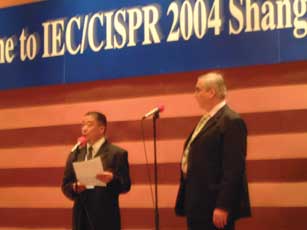 |
| Peter Kerry, Chair of CISPR, (right)
being introduced at the CISPR evening reception hosted by
the Chinese National Committee of the IEC. |
This year the CISPR plenary met (it meets every three years).
At the meeting, the subcommittee (SC) chairs were confirmed. There
were new faces as well as those who had been serving CISPR for
several years. The president of CISPR was also confirmed to serve
another three years. These leaders are as follows:
CISPR President: Peter Kerry (UK)
SC A (Measurements, Statistical Techniques and Uncertainty)
Chair: Don Heirman (USA)
SC B (Industrial, Scientific, Medical) Chair: Anton Kohling
(Germany)
SC D (Automotive) Chair: Poul Andersen (USA)
SC F (Appliances) Chair: Uwe Kampet (Germany) New Chairman
SC H (Limits) Chair: Bernard Despres (France)
SC I (ITE, Multimedia and Receivers) Chair: Martin Wright (UK)
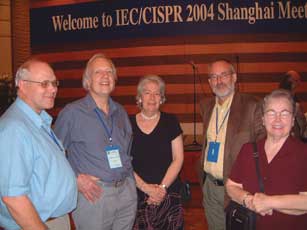 |
| All enjoyed the reception, including
(from left) Dave Eardley, Secretary of CISPR, Ray and Dorothy
Garrett (Australia), Jan Coenraads (The Netherlands) and Lois
Heirman (believed to related to Don Heirman?). |
The meetings were not all without social functions,
including a banquet as well as a reception. In the pictures included
in this column, you will see the President of CISPR being introduced
at the reception. Also shown are attendees of the reception. We
also had an opportunity to visit the Shanghai Institute of Measurement
and Testing Technology, National Center of Measurement and Test
for East China of the National Center of Testing Technology in
Shanghai. There we saw extensive EMC test facilities with large
drive-in semi anechoic and support chambers (the pyramidal absorber
material on the surfaces were 2 meters in depth!). We were also
treated one weekend as we signed up for tours of the fantastic
Shanghai area of 17 million people that could best be described
as “under construction” or “fully modern”
with new office buildings abounding the scene. Two facts were
presented to us, i.e. that 70 percent of the structural concrete
and 30 percent of the construction cranes in the world are used
in China! Near the end of that trip was a “green tea”
tasting experience that is shown in the photos as well as other
photos of the time off during the weekend for tours set up by
the Chinese National Committee.
 |
| Bill Hurst of the FCC (left) enjoys
the boat ride on the Hangzhou West Lake with Professor and
Mrs. Shuichi Nitta. |
Summary: All in all, it was a major 30 days of EMC standards activities
highlighted by our IEEE EMC Santa Clara meetings and continuing
through the CISPR meetings. We look forward to our next IEEE EMC
Symposium in Chicago next year followed by the next CISPR meeting
in South Africa. EMC
|
|
|
 EMC
Standards Activities and Meetings Abound!
EMC
Standards Activities and Meetings Abound!






